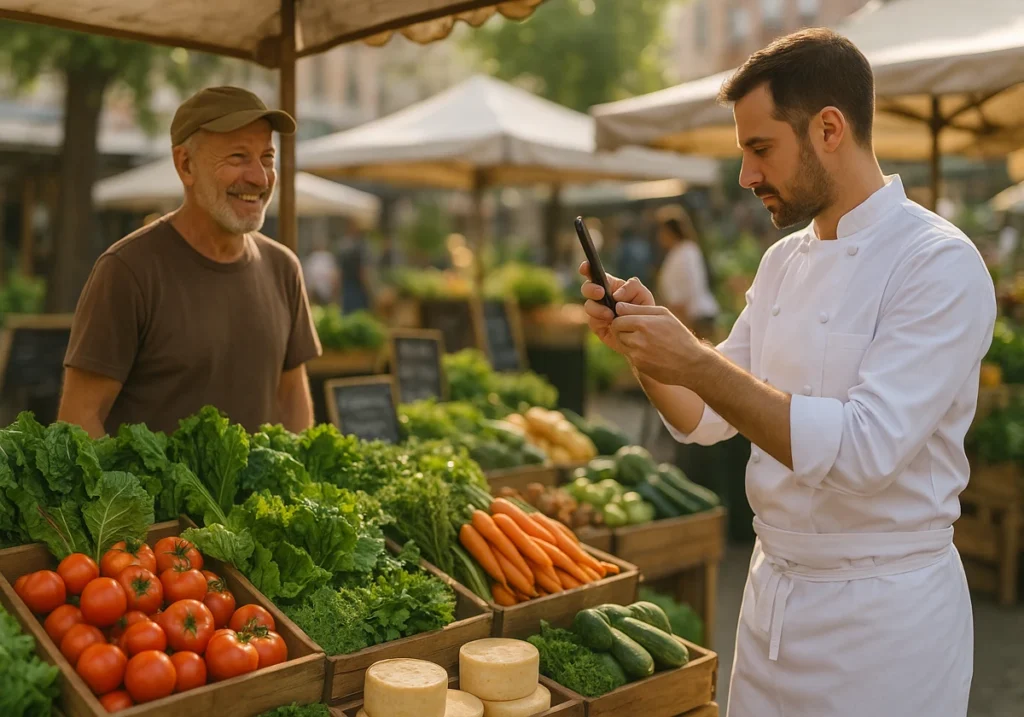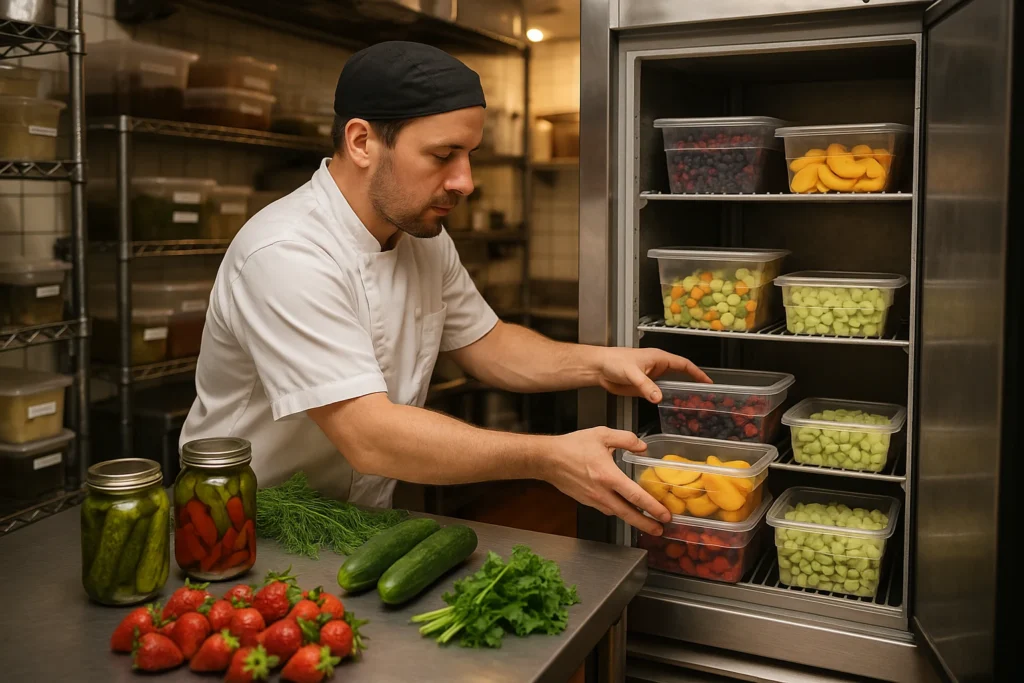Local ingredients make global menus shine because they deliver peak flavour, cut costs, and build customer trust. These days, restaurants using local produce are seeing something special happening than before. Their customers are paying more and coming back more often.
The secret of this phenomenon isn’t anything magical. It’s simply about using fresh ingredients from local farmers that just taste better. Because when you work with passionate producers who grow your food, you get something chain restaurants can’t buy: authenticity.
That’s exactly what this guide helps you achieve. We’ll show you how to shop locally without breaking your budget. You’ll also learn which challenges to expect and how to handle them.
So, let’s start with farm-fresh ingredients that change every cuisine.
Fresh Produce Enhances International Dishes
Local produce makes global menus better by delivering peak flavour and freshness that imported ingredients can’t match. Here are three ways fresh produce elevates your international menu:
Peak Season Flavour Elevates Any Cuisine
Did you know, seasonally ripe tomatoes taste completely different from the ones you import in the winter? The sweetness hits your tongue first. Then, when you cut it, juice runs all over your plate. That’s how seasonal produce from farmers’ markets delivers authentic flavour to global recipes.
When chefs in the Sunshine Coast grab basil in peak season, their Italian dishes taste like they came straight from Rome. Similarly, Thai curries get that punch when you use fresh local vegetables picked that morning (Freshness creates favours.)
Fresh ingredients picked yesterday beat month-old imports in taste and texture every time.
Shorter Supply Chains Mean Better Quality
Local farmers harvest produce at peak ripeness rather than shipping it early. That’s why your Strawberries actually taste sweet, and your Lettuce stays crisp for days.
These fresh produce also travels for hours, so vitamins stay locked in. And this shorter journey ensures your kitchen gets healthier food that lasts longer on your shelves.
Supporting Local Farmers Builds Menu Trust
Customers pay more when they know meals support nearby farming families. They often ask servers where the honey came from and want to meet the producers.
So, naming your supplier on menus proves you care about ingredient quality. Passionate producers also share harvest stories that set your restaurant apart from every chain in the region.
Farm-to-Table Builds Customer Loyalty
Ever wonder why some restaurants have lines out the door while others stay empty? The answer is farm-to-table menus, which naturally create repeat customers with diversity.
Customers return their diners when the menu stays static in all seasons. They visit in autumn to taste what’s different from summer. Sometimes, they even bring family and friends to try the new seasonal dishes.
When you source from farms around Flame Hill or the Sunshine Coast hinterland, customers notice the difference on their plate. Because it shows in every bite of fresher vegetables, better cheese, and fruit. And this quality keeps them coming back week after week.
Menu Transparency Attracts Modern Diners
Showing customers the source of their food builds trust that keeps them coming back. It helps them choose your restaurant over the place next door.
According to the National Restaurant Association’s 2020 Report, 76% of diners choose restaurants that label where ingredients come from. That’s what builds trust with your customers.
For example, when you write “tomatoes from Flame Hill” or “cheese from Sunshine Coast dairies” on your menu, people feel connected to their food. They know exactly what they’re eating and where it came from. That transparency makes a regular customer.
Social media posts about farm visits significantly drive engagement and new bookings.
So, how to do this? Well, take your phone to the farmers’ market on the weekend. Snap photos of producers, fresh fruits, and vegetables straight from the garden. Then, post them with stories about the source of tonight’s dinner and watch your followers become customers.

Building Community Through Your Menu Choices
The fastest way to stand out from chain restaurants is by connecting your menu to real people who grow your food.
Here are the types of communities you can build through your menu choices.
Passionate Producers Add Menu Stories
Chefs who visit farms create dishes inspired by what’s growing now. They see what’s ready to harvest and build their menu around it.
And here’s the interesting thing: building personal relationships with growers gives you access to premium stock. When producers know you’re committed to supporting local farmers, they’ll call you first about special items.
Fun fact: With this understanding, you get the best honey before it hits the markets. Fresh milk and yoghurts arrive at your door before anyone else gets a taste.
Sunshine Coast Hinterland Connections
Hinterland farms grow unique varieties you won’t find in standard catalogues. They’ve got fruits and vegetables that make your menu different from every other restaurant in the region.
These makers and producers also focus on quality over quantity. And deliver products straight from paddock to plate, bringing flavour that imported food can’t match.
Cooking Classes Showcase Regional Ingredients
Occasionally, you can arrange cooking classes because teaching your customers about seasonal cooking builds loyalty beyond single restaurant visits.
These classes will also show your commitment to supporting local farmers. Besides, hands-on experiences with fresh produce create connections people remember for months.

Overcoming Common Sourcing Challenges
Now that you know the benefits of local sourcing, let’s tackle the real-world difficulties that most restaurants face.
Managing Limited Availability Windows
Short harvest seasons force chefs to adapt menus quickly throughout the year. Because Strawberries disappear after summer, and Stone fruits only last a few weeks.
You can solve this crisis by preserving peak produce through freezing or pickling. Try buying extra vegetables when they are on sale at the market. Then freeze berries for winter desserts.. And don’t forget to pickle cucumbers to use for months.
These sustainable practices let you enjoy local taste even in the off-season. So, if you’ve ever tasted preserved peaches in winter that still capture that summer sweetness, you know exactly what we’re talking about.
Training Staff About Ingredient Origins
Servers who know farmer names confidently answer customer questions about sourcing. They can tell stories about the source of cheese or who grew the vegetables.
Also, they waste less by understanding the significance of seasonal produce. If they know fresh food costs more and tastes better, they handle it with care. And use every bit instead of tossing half in the bin.
Let the staff visit the farm regularly to know these things better.
Balancing Global Flavours With Local Stock
International recipes adapt beautifully when you substitute available seasonal produce. For instance, Vietnamese pho works well with local greens instead of imported herbs.
On the other hand, Asian dishes shine with local vegetables even without imported specialty items. These creative substitutions maintain authentic flavours while bringing regional character to every bite.

Final Words
Now, you know how much local ingredients can change everything for a restaurant. From sources like farmers’ markets and the Sunshine Coast, you get better taste, lower costs, and loyal customers.
So, start small from today. Visit one farmers’ market this weekend. Meet a producer from Flame Hill and build a relationship with a local dairy or farm.
For more inspiration on creating memorable menus with quality ingredients, visit Byblos Philly. Because your kitchen deserves the best, and local produce delivers it.
